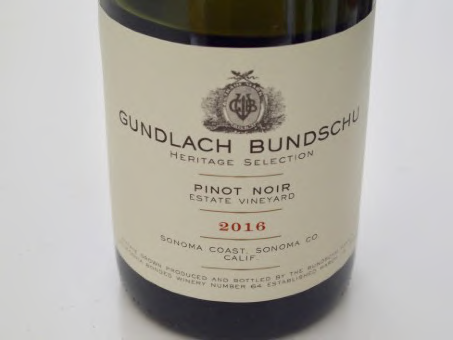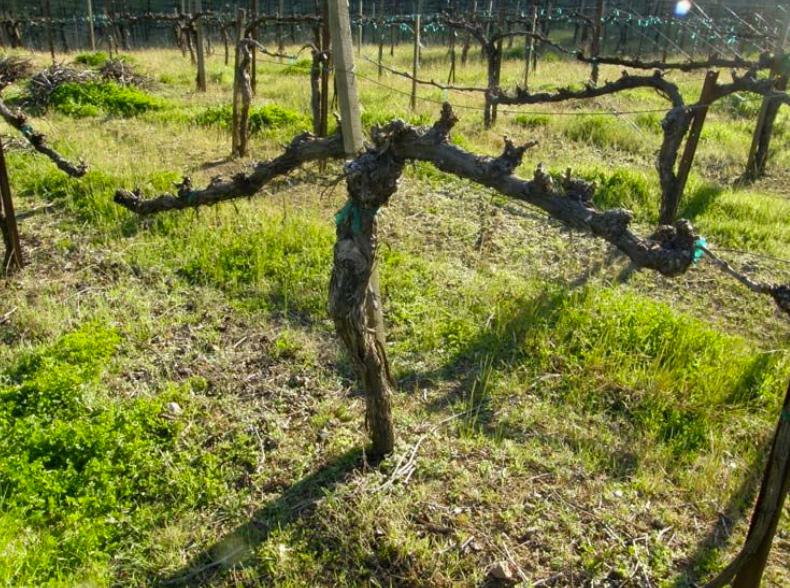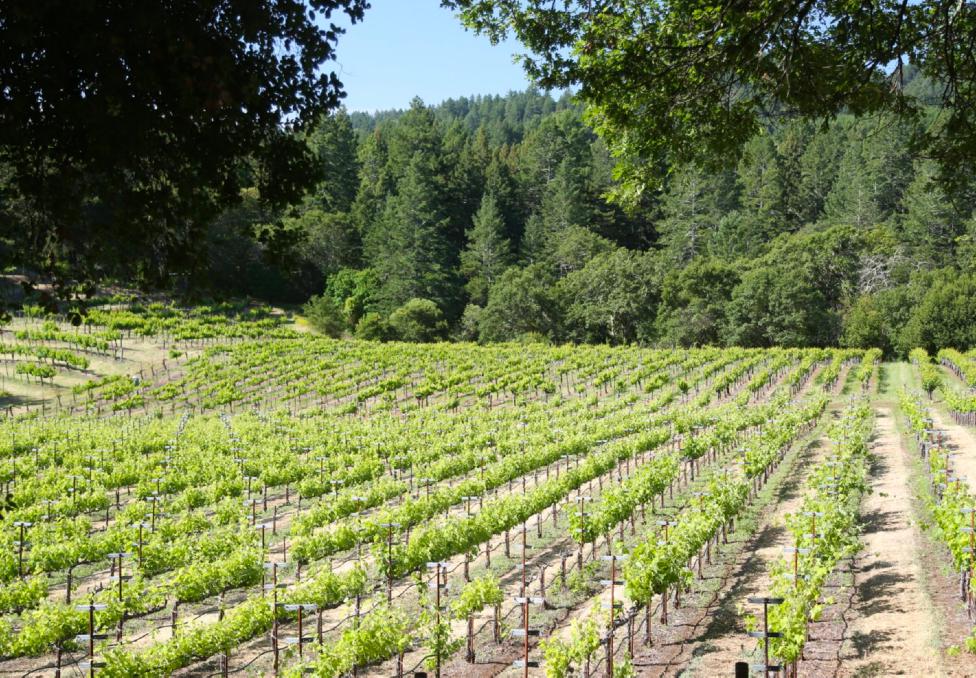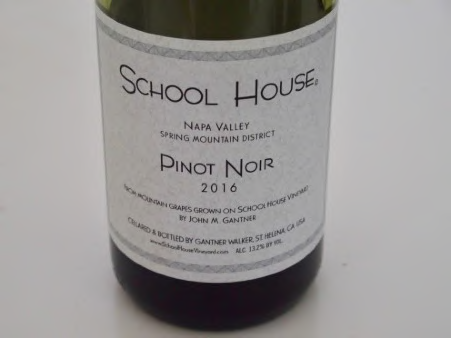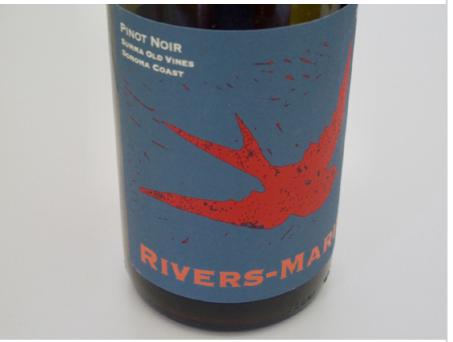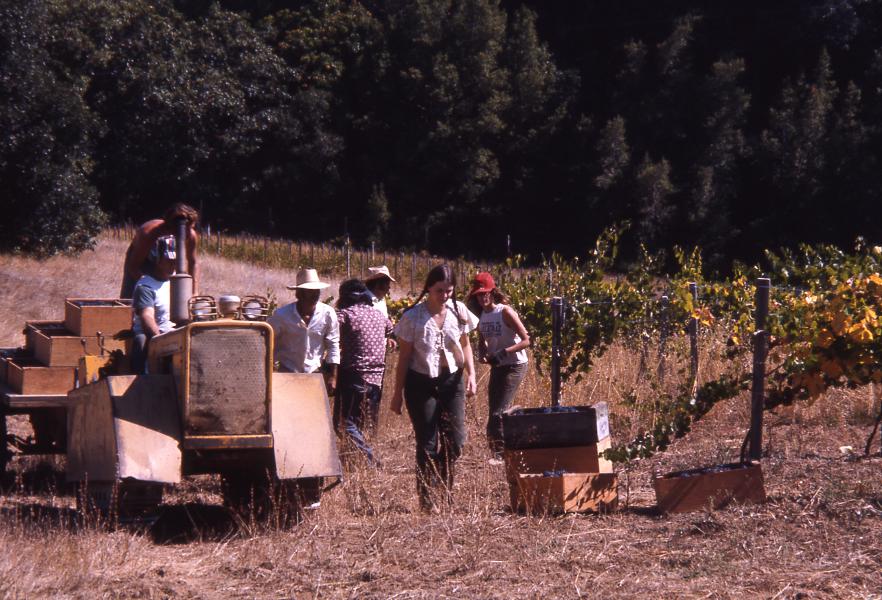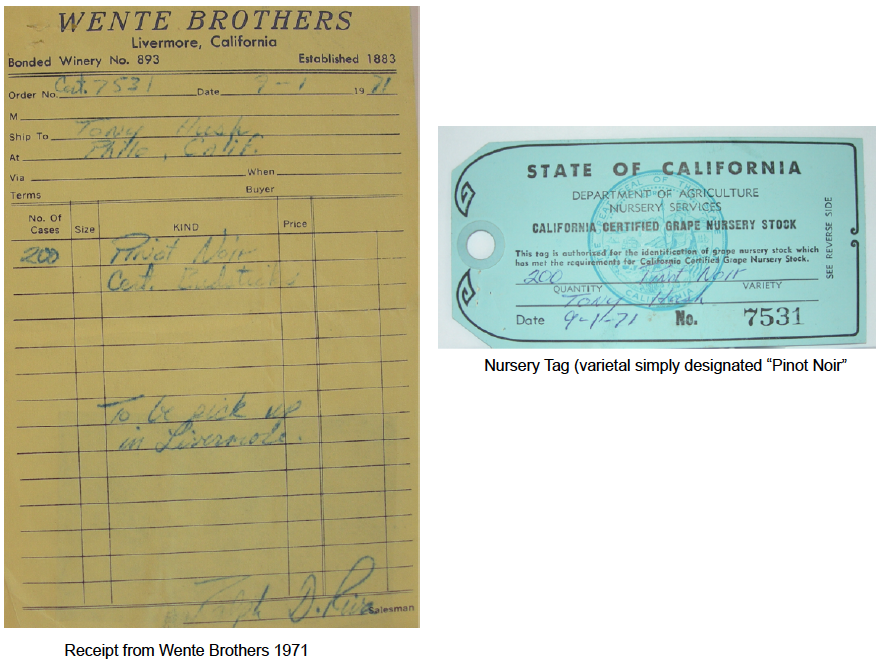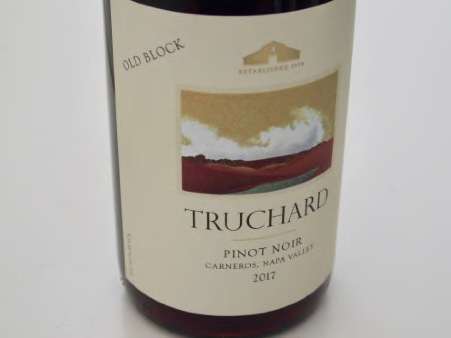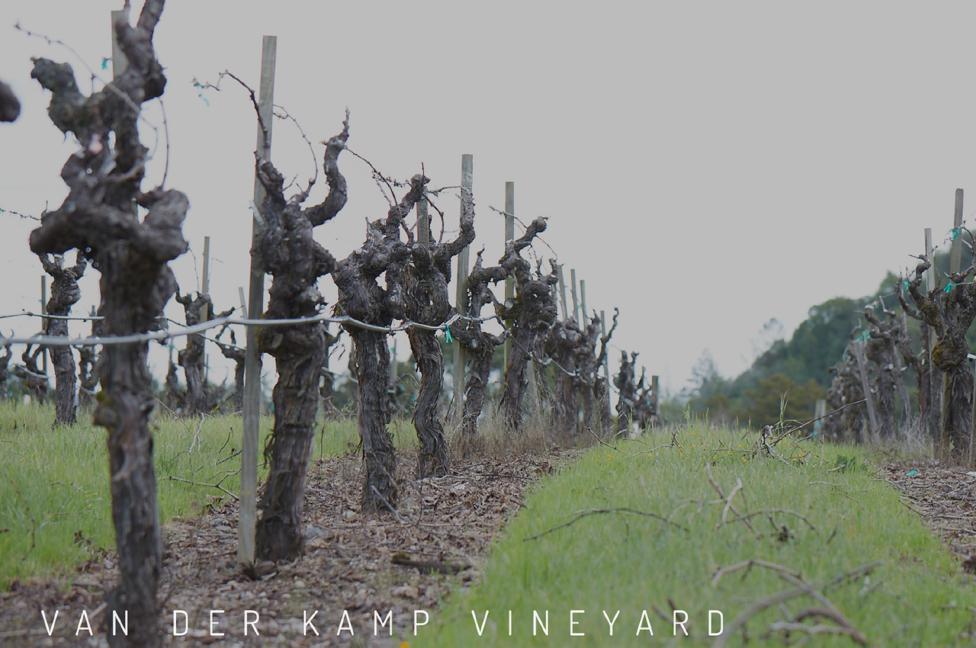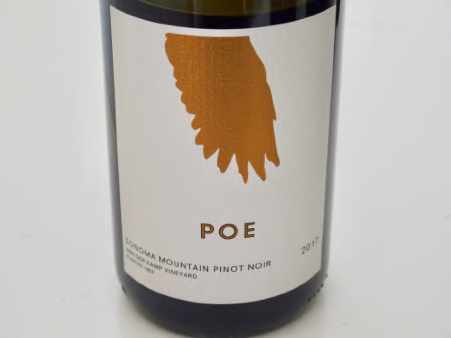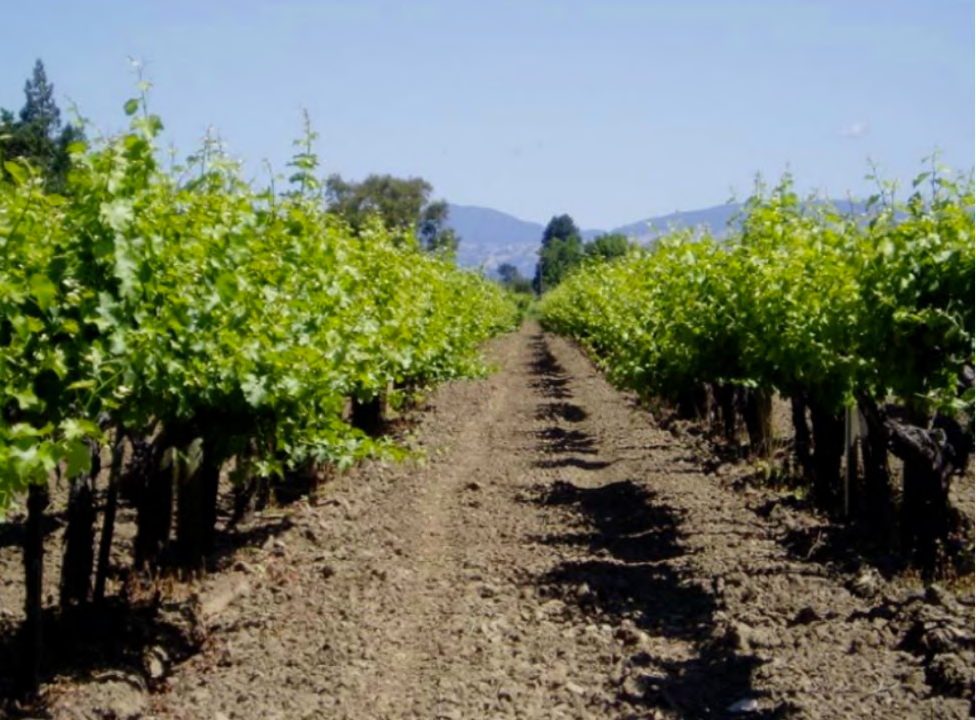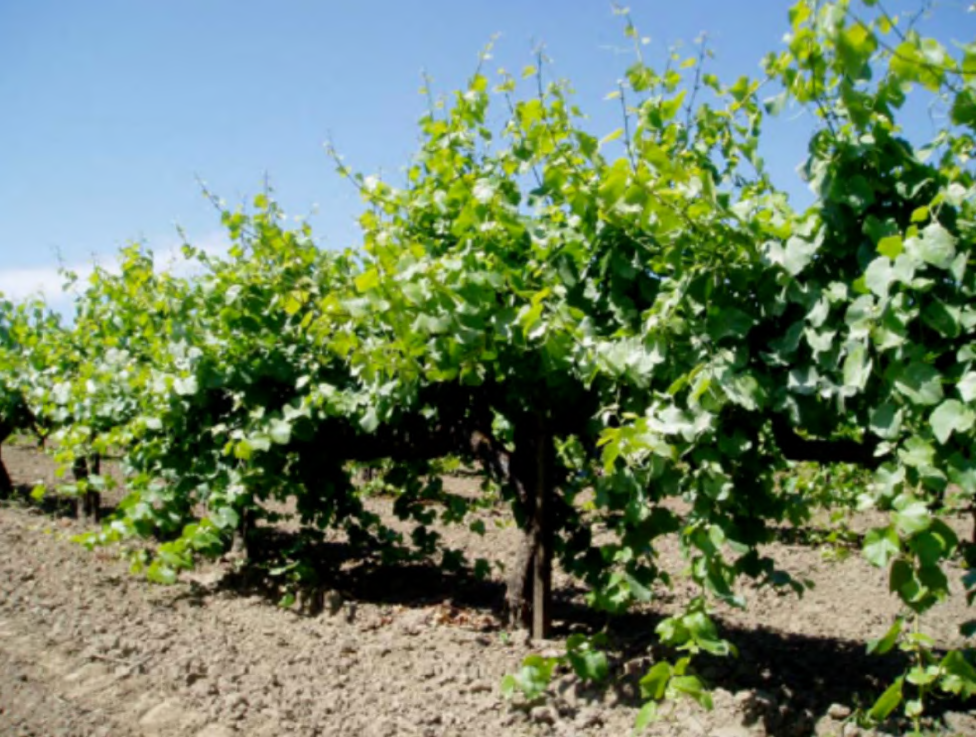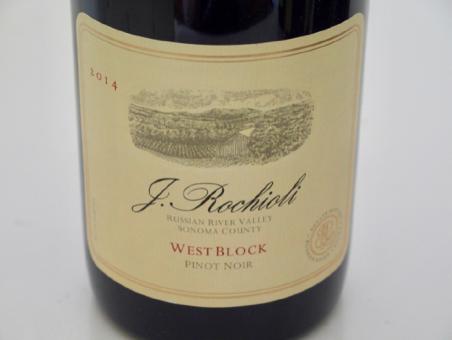California Old Vine Pinot Noir Vineyards: Sonoma/Napa Counties - R-W
“Time is important because if there is an expression of terroir in wine, then it must by its nature
change over time. Not evolve, but simply show different aspects with each vintage, yet within the
context of change retain a pure core of meaning or expression of terroir.”
Larry Walker, wine journalist
Rhinefarm Vineyard
Location: Sonoma Valley
Owner: Gundlach Bundschu
Initial planting: 1970s
Acres: 14
Scion: Martini 12, Hanzell selection, “Hacienda” selection
Producer from this vineyard: Gundlach Bundschu
Gundlach Bundscu is the oldest family-owned and operated winery in California (bonded winery 64,
established March 12, 1958.
Pinot Noir is the winery’s second-largest crop after Cabernet Sauvignon. Of the 47.5 acres planted to
Pinot Noir, 80% are Dijon clones 115, 667 and 777 and Pommard clone, and 20% are 45+-year-old
heritage selections. According to John Haeger, the winery’s Rhinefarm Estate Vineyard contains 14
acres of heritage selection plantings that date from the 1970s. Rhinefarm was extensively replanted
between 1969 and 1973 and was expanded by the acquisition of adjacent land in 1970 and 1973.
With this acquisition came a master transition plan for the vineyard and a commitment to raise the
wine quality ambitions. Rhinefarm now has 320 acres under vine.
The vineyard is located on the southwestern slopes of the Mayacamas Mountains. Pinot Noir is grown
across the street from the Carneros AVA border. It shares cooling effects of the fog from San Pablo
Bay to the south and the Petaluma Gap to the west. The soil is 18”-30” Huichica clay topsoil with
pockets of gravelly sediment deposited over centuries by the adjacent Arroyo Seco Creek.
The distinct block of 45+-year-old heritage wines is harvested for a limited barrel selection bottling of
Heritage Selection Pinot Noir. The wine is available exclusively through allocation. Visit
www.gunbun.com.
2016 Gundlach Bundschu Heritage Selection Sonoma Valley Pinot Noir
14.5% alc., pH 3.85, TA 0.56, $65.
Aged 10 months in French oak barrels, 40% new.
·
Moderately light garnet color in the glass. The nose opens
slowly to reveal aromas of black cherry, blackberry, rose
petal and vanilla. Very ripe fruited and husky in style, with
sappy flavors of black cherry and blackberry fruit with an
accompaniment of loamy earth and peat notes. Their is a
modest oak veil offering a touch of vanilla. Velvety in the
mouth with a hint of alcoholic warmth on the generously
fruited finish.
Score: 90
Ritchie Vineyard
Location: Russian River Valley Laguna Ridges
Owner: Kent Ritchie
Initial planting: 1972
Acres: 3
Scion: Martini 13
Producer from this vineyard: Woodenhead Vintners
This Ritchie Vineyard is located just down the street from the Swan Trenton Estate Vineyard at the
intersection of Eastside Road and Eastside-Healdsburg Road in the Russian River Valley. This 65-
acre property was planted in 1972 to Old Wente Chardonnay and Martini Pinot Noir on AxR rootstock.
The 3-acre block of original Pinot Noir plantings is still producing but some vines have been replaced
due to problems with Pierce's Disease (Kent estimates more than 50% of the vines are original).
This iconic vineyard is situated adjacent to a volcanic cinder cone that accounts for its unique soil
composition. The topsoil is Goldridge with underlying pumice not found elsewhere in the Russian
River Valley. Winemakers swear that this soil gives the wines from this vineyard a prominent
minerality.
The original vine block of Pinot Noir is sourced exclusively by Nicolai Stez, owner and winemaker of
Woodenhead Vintners who bottles a Pinot Noir from these Pinot Noir grapes and named "Cinder
Cone." Nicolai was a long-time assistant to Burt Williams at Williams Selyem. I recently tasted several
vintages. The wines are consistently excellent. If you liked Burt Williams' Williams Selyem Pinot Noirs,
you will like these wines. Visit the Woodenhead Vintners website for availability:
www.woodenheadwine.com.
2010 Woodenhead Ritchie Vineyard Cinder Cone Russian River Valley Pinot Noir
14.0% alc..
·
Dark garnet color in the glass. Nicely perfumed with aromas of black cherry, cassis and purple grape
with a compliment of seasoned oak. Mid-weight plus in style, with a bombastic core of black cherry
fruit backed by mild supportive tannins.Silky in the mouth with a moderately long finish. Impressive
fruit presence after ten years and has the balance to drink well for another 5 years at least.
Score: 93
2012 Woodenhead Ritchie Vineyard Cinder Cone Russian River Valley Pinot Noir
13.8% alc..
·
Moderately dark garnet color in the glass. Welcoming aromas of black cherry, dried brush, cardamom
spice and dried rose petal. The flavors of well-ripened black cherry and blackberry come together in a
mid-weight plus style that benefits from gracious tannins and subtle oak. Easy to like, with excellent
harmony and an exuberantly fruity finish.
Score: 93
2013 Woodenhead Ritchie Vineyard Cinder Cone Russian River Valley Pinot Noir
13.0% alc..
·
Dark garnet color in the glass. Intoxicating aromas of black cherry, spice cabinet, floral goodness and
seasoned oak. Sleek and comforting in the mouth with reserved tannins and a juicy acid undertone.
The mid-weight plus flavors of black cherry, strawberry and cola impress as does the lengthy, sweet
cherry finish.
Score: 94
2014 Woodenhead Ritchie Vineyard Cinder Cone Russian River Valley Pinot Noir
13.0% alc.,
$65.
·
Dark garnet color in the glass. A Pinot nose to die for, with the perfume of black cherry, spice and
rose petal. Nothing is out of place in this mid-weight plus styled beauty offering layers of gregarious
dark cherry and purple berry fruits that caress the palate with silkiness. Impeccable harmony and a
lengthy finish that provides a juicy citric edge. This wine tastes damn good just like mothers milk.
Score: 95
2015 Woodenhead Ritchie Vineyard Cinder Cone Russian River Valley Pinot Noir
13.4% alc., $65.
·
Dark
garnet color in the glass. Leading off are enticing scents of
dark cherry and berry and forest floor. Full-bodied in style,
with a reaching, expansive core of spiced black cherry fruit
that keeps opening and opening in the glass. Richly
endowed with fruit sap yet endlessly gentle. Ready now for
prime time with ripe, gracious tannins and a very long
finish brimming with fruit goodness.
Score: 95
School House Vineyard
Location: Spring Mountain, Napa Valley
Owner: John M. Gantner and Nancy Walker
Initial planting: 1952/1953
Acres: 4
Scion: Inglenook Estate plantings, probably a Burgundy suitcase selection
Producer from this vineyard: School House Vineyard
John O. Gantner (John Sr.) acquired 160 acres on Spring Mountain in 1938. He had been looking for
property in the Mayacamas Mountains at the urging of his college fraternity brother at Stanford
University, John Daniel, who became the owner of Inglenook Vineyards. John Sr. loved Burgundy
wines and decided to plant Pinot Noir in the School House Vineyard, acquiring the budwood (rumored
to be from Domaine Romanée-Conti) from John Daniel. André Techelistcheff had advised Daniel to
pull out his Pinot Noir plantings believing that the Napa Valley floor soils were too vigorous for Pinot
Noir vines. Tchelistcheff was encouraging local growers to remove other varieties and replace them
with Cabernet Sauvignon. In 1952, Daniel removed his acre of Pinot Noir in Rutherford and donated
budwood to John Sr.
The original vines on the School House property date to the 1870s and were a field blend. At the time
of John Sr’s purchase, there were 30 acres under vine and the vineyard had been previously
managed with horses. It had been neglected for years and the vineyard was overgrown with poison
oak, wild roses and brush. He managed to take back the property from the woods and brush, working
for over ten years to restore its former glory as a viticultural oasis. Today, some of the field blend
wines have been replanted and a School House Zinfandel-based Mescolanza and Syrah-based
Mescolanza are produced as a modern interpretation of the field blend.
The vineyard was named after a small one-room schoolhouse built on the property in 1881. John Sr’s
family lived in the schoolhouse for several years after acquiring the property but it burned down in
1986. John Sr. passed away in 2002.
I recently spoke with John M. Gartner (John Jr.) and he remembers that the original planting was in
1952 and 1953 when John was 13 years old. He helped dig the holes and plant the vines. Emmolo Nursery, founded in Rutherford by Salvatore Emmolo in 1923, provided the St. George rootstock and did the budding. If John
Jr.’s recollection is correct and I have no reason to doubt him, the 1952-1953 School House Vineyard
original plantings of Pinot Noir are the oldest producing Pinot Noir vines in California along with the
Ambassador’s 1953 block at Hanzell that was also planted in 1953. Interestingly, the Zellerbachs, who
owned Hanzell, and the winemaker at Hanzell, Bob Sessions, were friends of John Sr. and traded
cases of wine with each other every year.
Original Own Rooted Pinot Noir Vine School House Vineyard (2012)
School House Vineyard
John Jr. recalls that when his father first planted Pinot Noir at School House Vineyard, there were no
operating wineries on Spring Mountain and the spotting of an automobile on the roads was a rarity. To
this day, he is fond of the tranquillity at School House Vineyard, although road traffic and noise have
perceptibly changed for the worse in recent years. John Jr. has not been back to San Francisco in
several years.
The first School House Vineyard Pinot Noir was released in 1957, making the winery one of the
longest continuously operating wine producers in the Napa Valley. Chardonnay was planted in the late
1960s using budwood from Fred McCrea’s Stony Hill Vineyard Currently, 12 acres of vineyard are
farmed including 6 acres of old vine Pinot Noir supplemented with 1 acre of 18-year-old vines and 1
acre of 14-year-old vines. Additional vine-by-vine plantings of Pinot Noir using the original budwood
within the past 18 years are mostly on 110R rootstock. John Jr. told me recently that in the 2019
vintage, about 35% of the vines are at least 50 years of age with additional vines over 40 years old.
The vineyard is located in a uniquely cool microclimate at 1,500 feet elevation with well-drained soils
making it one of the few successful Pinot Noir growing sites in the Napa Valley.
John Jr. followed his father to Stanford University and practiced law in San Francisco for 35 years
before retiring to the School House Vineyard property in 1992. Jr and Nancy Walker have farmed the
School House Vineyard ever since. They live on the property and John has done much of the
vineyard work by hand. John had been coming to his father’s property practically every weekend
since he was born and his viticulture knowledge has been acquired through years of experience and
interaction with neighboring winegrowers on Spring Mountain. He remembers drinking a variety of
wines growing up at the family dinner table and recalls tasting the wines of Martin Ray as a
comparison to their own School House Pinot Noir. The family was struck by the variability of Ray’s
wines (something many others have noted), and John Jr. told me, “They could be very good or very
bad, but you could never tell him that.”
The School House Pinot Noir was initially vinified at Stony Hill (a bottle of 1959 vintage vinified at
Stony Hill Vineyard that John Jr. showed me follows), then Buena Vista Sonoma and subsequently at
other wineries. Several winemakers were involved including André Tchelistcheff, Ric Forman, Mike
Chellini and Bo Barrett of Chateau Montelena. The School House Vineyard wines have been crafted
at Pride Mountain Vineyards since 1997, initially under the direction of winemaker Bob Foley and now
custom crushed by the current Pride winemaking team headed by Sally Johnson.
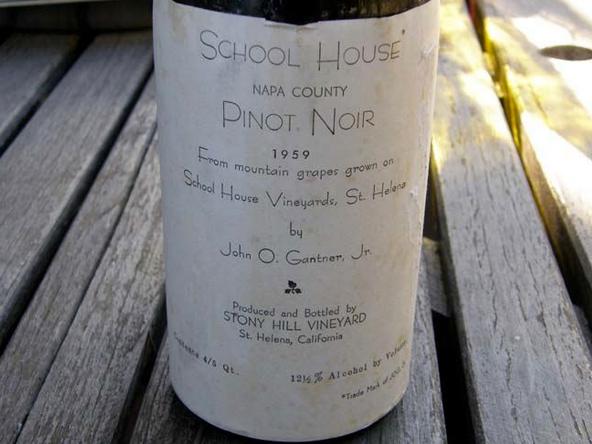
The 2007 School House Vineyard Pinot Noir, now sold out, was the 50th vintage of this wine. The
wines have proven to age remarkably well despite the variety of wineries and winemakers involved in
production through the years. Consistency has been a hallmark of the wine, a testament to the unique
terroir of the site, its dry-farmed vines, and the lack of nod to modernization. The School House
Vineyard Pinot Noirs are not California mainstream Pinot Noirs but are terroir-driven, unique wines
that can only be understood and valued in the context of their origin from this historical vineyard.
Today, about 3,000 cases of four wines are produced: Pinot Noir, Chardonnay, and the two
Mescolanza red blends. The wines are sold only through a mailing list at
www.schoolhousevineyard.com. Tasting is by appointment at the vineyard property.
To read more about the fascinating history of School House Vineyard consult
www.napawinelibrary.com/reports/2009/summer/gantner, www.napawineproject.com/schoolhouse-
vineyard/ and www.princeofpinot.com/article/1202/ titled “School House Vineyard, Cult
Before Cult was Cool.”
2015 School House Vineyard Napa Valley Pinot Noir
13.6% alc., $70. Small percentage of whole
cluster. Aged 18 months in 100% new French oak barrels. Bottled unfined and unfiltered.
·
Moderate
garnet color in the glass. Unusual aromatic profile, offering scents of black cherry syrup, spice, turned
earth and exotic floral notes. Mid-weight plus in style, featuring a sappy core of fresh black cherry and
black berry fruits with a spice, floral and earthy tone in the background. Mild, gritty tannins show up on
the persistent and intensely fruity finish. Oak plays a supportive role. When tasted the following day
from a previously opened and re-corked bottle, the wine seemed more harmonious, with less tannin
evident and a more lengthy finish.
Score: 94
2016 School House Vineyard Napa Valley Pinot Noir
13.2% alc., $65, 1.5 L $130. Small percentage of whole
cluster. Aged 18 months in 100% new French oak barrels.
Bottled unfined and unfiltered.
·
Moderately light garnet
color in the glass. Welcoming aromas of black cherry, dark
red rose petal and a compliment of fresh oak. My notes
start with “Wow!” Black cherry and raspberry fruits really
pop in the mouth, becoming expansive and holding court
through a very long finish. Fully integrated tannins with a
very sleek texture. Enviable balance. When tasted the
following day from a previously opened and re-corked
bottle, the fruit showed even more intensity and
persistence while a savory dried herb and earth note
showed up. This wine makes a remarkable first impression and then returns over time to offer more
glorious Pinot love.
Score: 96
Summa Vineyard
Location: Taylor Lane west of the town of Occidental in the West Sonoma Coast
Owner: Thomas Rivers Brown
Initial planting: 1979
Acres: 2
Scion: ? Swan selection
Producer from this vineyard: Rivers-Marie
This vineyard was first planted by Steve Young in 1979. The original 2 acres of vines included Pinot
Noir, Chardonnay, and Gewürztraminer but the latter two varieties were grafted over to Pinot Noir soon
after the 1979 planting. The source of the original Pinot Noir plantings has been subject to
considerable conjecture over the years.
Scott and Joan Zeller acquired the vineyard in 1982 and farmed it until Thomas Rivers Brown bought
it in September 2010. The Zellars either do not know or decline to disclose the plant material origins.
Burt Williams, who crafted Pinot Noir from Summa Vineyard from 1988 to 1997, suspected the
original vines were a Swan selection.
In 1998, an additional 3 acres of Pinot Noir were planted on resistant rootstock using cuttings from the
old vines and these plantings are referred to as Summa Young Vines. In 2005 and 2009, an
additional 1.5 acres of Pinot Noir was planted adjacent to the Zeller’s residence using old vine budwood
, and this block is known as the Driveway Block New Vines.
Since 2015, Thomas has removed underperforming, severely diseased, dead and tractor-damaged
vines at the rate of five to six vines per year, interplanted among the old vines and planted a Calera
selection.
Yields were minuscule in the early years of this vineyard's existence. Williams Selyem was only able
to produce a Summa Vineyard bottling in 1988, 1991, 1995, and 1997. Declassified lots of Summa
Vineyard grapes were blended into the Williams Selyem Sonoma Coast bottling in other years. The
1991 and 1995 vintages of Williams Selyem Summa Vineyard Pinot Noir are legendary. I reviewed
the 1995 vintage years ago: www.princeofpinot.com/winery/154/
Prior to Thomas' acquisition of the vineyard in 2010, grapes were sold to Rivers-Marie, Mueller
Winery, Brogan Cellars and Littorai. Since 2010, Summa Vineyard has been a monopole of Rivers-
Marie and both a Summa Vineyard Sonoma Coast Pinot Noir (now 22-year-old vines) and a
Summa Vineyard Old Vines Sonoma Coast Pinot Noir have been offered to a mailing list:
www.riversmarie.com. I have reviewed practically every Rivers-Marie Summa Old Vines Pinot Noir
from 2002-2018: www.princeofpinot.com/winery/585/
2018 Rivers-Marie Summa Vineyard Old Vines Sonoma Coast Pinot Noir
13.3% alc., 210 cases, $80. Harvest Brix
23.8º.
·
Moderately light garnet color in the glass. The
enticing hose is a wonderland of aromas including cherry,
spice, forest floor and pine needles. The dreamy texture
makes an impression immediately. Very enjoyable upon
opening in a light to mid-weight style featuring a core of
well-spiced redder fruits. A stellar wine with engaging
freshness and gossamer tannins, finishing unusually long.
There is something about this wine that is hard to put into
words but you know it is special. Perhaps it is the fact that it
offers complexity rather than brute sap. Most certainly, it is
the forty-year-old vines speaking. In any case, this beauty
has the balance to age for many years and I am sure will brings many oohs and ahas down the line.
Still magnificent when tasted the following day from a previous opened bottle.
Score: 95
2008 Rivers-Marie Summa Vineyard Old Vines Sonoma Coast Pinot Noir
14.1% alc., Magnum. I
reviewed this wine in June 2010 and raved about it:
·
“Enticing perfume of fresh red cherries and
berries with nuances of dark chocolate, Moroccan spices, anise, smoke and savory herbs. The fruit is
robust, virile and mouth coating and persists through a generous finish.” I tasted the wine again in
July 2012, “Delicious black cherry core with very slight creosote and smoke flavors.” I also tasted the
wine in March 2017: “Still rather bold with a copious core of very ripe cherry and berry fruits with a riff
of smoke taint in the background.” This magnum was tasted recently. The wine opens initially with
aromas of black cherry, mocha and stem but becomes flat rather quickly. Mid-weight plus in style and
creamy on the palate with layers of black cherry, blackberry and pomegranate flavors framed by
silken tannins. There is clearly some smoke taint evident on the finish. Many Sonoma Coast Pinot
Noirs suffered smoke taint from wildfires in 2008. When tasted initially, this wine was terrific, but with
age, smoke-tainted Pinot Noir tends to become less fruity and displays more evidence of creosote,
something evident in this magnum tasted in 2020. That said, the wine was still quite enjoyable and
probably only a wine critic would find fault in the wine.
Score: 90
The Knoll Vineyard
Location: Anderson Valley
Owner: Husch Vineyards (Amanda Robinson Holstine and Zack Robinson)
Initial planting: 1971
Acres: 2.5
Scion: Wente field selection from Wente’s Arroyo Seco Vineyard
Producer from this vineyard: Husch Vineyards
Husch Vineyards planted the first Pinot Noir vines in the Anderson Valley and established a winery in
1971 making Husch the oldest licensed winery in Anderson Valley. Tony and Gretchen Husch bought
the 60-acre Nunn ranch located between Philo and Navarro on Highway 128. They planted rootstock
for Pinot Noir in either 1968 or 1969 and field grafted The Knoll in 1971. At the time, it was more
common to plant roots first and then graft the variety a couple of years later.
The first harvest in 1973 at Husch Vineyards
They planted eight acres of Pinot Noir, Chardonnay, and Gewürztraminer grapes on the cool slopes of
the property that swept down towards the Navarro River. Tony learned from locals that neither
Zinfandel or Cabernet Sauvignon would ripen on the valley floor so he thought he would give Pinot
Noir a try. The original Pinot Noir plantings at The Knoll Vineyard consist of 2.5 acres, 12’ x 8’ spacing
with a single wire initially but converted to Lyre quad and interplanted in the late 1990s.
Hugo Oswald, Jr., a neighboring grape grower, bought the Husch Winery from the Husch family in
1979 and today the property remains owned and operated by the third generation of the Oswald
family: Amanda Robinson Holstine and Zac Robinson. Vineyard manager Al White has been at Husch
since 1974.
Interestingly, Zac told me is that not only was The Knoll the first planting of Pinot Noir in the Anderson
Valley, it was the first planting of any red varietal that could ripen reliably. Economically, however,
Pinot Noir was a dud! Zac’s records show that Gewürztraminer was far more valuable in the 1970s.
The Knoll Vineyard site is a south-facing outcrop of sandstone with shale lenses and good drainage
planted originally in 1971 and affectionally known as “The Knoll.” Interplanting of The Knoll Vineyard
with Dijon 667 began in 2001. Most of the original vines are still in production.
I have reviewed The Knoll Vineyard Pinot Noir from 2004, 2005, 2009, 2010 and 2013 vintages:
www.princeofpinot.com/vineyard/169/. The 2017 Husch Vineyards ‘Knoll’ Anderson Valley
Pinot Noir is available on the winery’s website at www.huschvineyards.com
2017 Husch Vineyards Knoll Anderson Valley Pinot Noir
12.9% alc., pH 3.50, TA 0.60, 504 cases, $42.
·
Harvest Brix 22.6º. 25% whole cluster. Aged 10 months in
French oak barrels, 40% new. Moderately light garnet
color in the glass. Intriguing aromas of cherry, raspberry,
pitch and pine needle. On the palate, there is plenty of
tasteful, earth-kissed cherry fruit in a middleweight,
agreeable style. Refined and sophisticated, with subtle
tannins, a delicate touch of oak and a very long-lasting
and juicy finish. The earthiness is very cordial. This wine
does not taste like any other wine reviewed for this study
of old vine Pinot Noir making it particularly distinctive. In
addition, it overdelivers for the price.
Score: 95
Three Corner Vineyard
Location: Russian River Valley (Healdsburg)
Owner: J. Rochioli Vineyards & Winery
Initial planting: 1974
Acres: 3.7 acres
Scion: West Block selection (“Rochioli clone”)
Producer from this vineyard: J. Rochioli Vineyards & Winery
Three Corner Vineyard was originally part of the Allen Vineyard but was deeded to Joe Rochioli, Jr. by
Howard Allen as a favor for farming the Allen Ranch for many years. The vineyard is now one of the
Rochioli estate vineyards.
About 60%-65% of the original plantings from 1974 are still in production. Later plantings were
established using the West Block selection, and Pommard 4 and Dijon 115 clones.
Three Corner Vineyard, West Block, Little Hill, Big Hill, River Block and Sweetwater are single block/
vineyard-designated Pinot Noir bottlings only sold through a mailing list at
www.rochiolivineyard.com. The 2018 vintage of Three Corner Vineyard is now offered at $90. The
2017 Three Corner Vineyard Pinot Noir was reviewed in May 2020.
2017 J. Rochioli Vineyards & Winery Three Corner Russian River Valley Pinot Noir
14.5% alc.,
$90.
·
Moderately dark garnet color in the glass. The nose opens slowly over a few hours to reveal very
enticing aromas of red and black cherry, baking spices and forest floor. Mid-weight plus in
concentration with flavors of blackberry and black raspberry that make a powerful statement. A little
rugged, rustic and earthy early on but when sampled several hours later, the unctuous fruit was more
amendable and vivid. The tannins were quite easygoing, the texture was soft and the finish had
unusual potency and staying power.
Score: 95
Trenton Estate Vineyard
Location: Laguna Road in the Russian River Valley, in a subregion of the Russian River Valley known
as the Laguna Ridges, near the town of Forestville.
Owner: Rod and Lynn Swan Berglund
Initial planting: 1969
Acres: 11 (current)
Scion: Martin Ray Vineyard (now Mount Eden) via the Experimental Station in Oakville. Also probably some
DRC suitcase selections that were given to Joe Swan. An additional block of Pinot Noir was planted in
1974 just south of the original planting using budwood from the best performing original vines
grafted onto nursery selection roots.
Producer from this vineyard: Joseph Swan Vineyards
The legendary Joseph (Joe) Swan first planted Pinot Noir along with Chardonnay and Cabernet
Sauvignon beginning in 1969, replacing a 13-acre plot of run-down Zinfandel that he acquired in
1967. It was Joe’s friend, Andre Tchelistcheff who advised him to plant Burgundy varieties on this site.
These original plantings are the oldest producing Pinot Noir vines in the Russian River Valley.
The property Joe purchased in 1967 also included a barn and a 100-year-old house that at one time
had been the post office and general store for the tiny town of Trenton that is no longer in existence.
The Swan Trenton Estate Vineyard, although located only a few miles from the Middle Reach
subregion of the Russian River Valley, is cooler, foggier, and wetter than that subregion marked by
Westside Road.
A Pinot Noir from the Swan Vineyard was sourced entirely from the original 1969 and 1974 plantings
from 1973 to 2002. The “Trenton Estate” designation did not appear until 1997. After 2002, some
young vine fruit was added. In the mid-1990s, Rod replanted half of the Trenton Estate Vineyard.
Today, the young vines have reached enough maturity that the Trenton Estate Vineyard bottling is
sourced from all blocks and twelve different planted clones. The Trenton Estate Vineyard also has an
acre of Syrah, and a few older Viognier, Chardonnay, and Cabernet Sauvignon vines.
Historically, cuttings from Swan’s vines were eagerly sought after, and because of Joe’s generosity,
became widely distributed to other California vineyards as the Swan clone (incorrectly) or the Swan
selection. It was Francis Mahoney, the founder of Carneros Creek Winery, who coined the term “Swan
clone” for the vine mix of Joe’s original plantings.
I have reviewed Joseph Swan Vineyards Trenton Estate Vineyard Russian River Valley Pinot Noir
from vintages 2001-2010 inclusive and 2013: www.princeofpinot.com/vineyard/175/. No grapes are
sold from this vineyard. The winery sells through its mailing list and tasting room:
www.swanwinery.com.
Truchard Estate Vineyard
Location: Napa Carneros
Owner: Tony and JoAnn Truchard
Initial planting: 1974
Scion: Martini selection
Producer from this vineyard: Truchard (Old Block)
The Old Block at Truchard Vineyards was planted to Chardonnay, Pinot Noir, Merlot and Cabernet
Sauvignon on the Napa side of Carneros in 1974. Dr Tony Truchard bought a 20-acre prune orchard
in 1973 while he was still practicing medicine. Francis Mahoney, of nearby Carneros Creek Winery,
assisted with the initial plantings of 20 acres. All grapes were sold exclusively until 1989 when the
Truchards began making their own wine. The original plantings of Pinot Noir on St. George rootstock
and designated the Old Block, are still producing.
When Tony first planted grapes in the early 1970s, Carneros was primarily an area known for sheep
and cattle ranches, and farmers were discouraged from planting grapes because of the cool climate,
clay soils that did not retain moisture, and meager, salty groundwater. Truchard Vineyards, however, is
located in the northeastern corner of Carneros at the base of the southern tip of the Mayacamas
Mountains with a diversity of soils including clay, shale, sandstone, lava rock, and volcanic ash as well
as various microclimates. With the low water table in Carneros, Tony was one of the first winegrowers
to adapt reservoirs for rainwater catchment and drip irrigation.
Today, Truchard Estate Vineyard is 383 contiguous acres, of which 270 acres are planted to ten
different grape varieties. Visit the winery website to purchase Old Block Pinot Noir:
www.truchardvineyards.com.
2017 Truchard Old Block Carneros Pinot Noir
14.1%
alc., $65. A very limited production wine based on Martini
selection planted in 1974 on St. George rootstock. These
are some of the oldest producing vines in Carneros. 100%
de-stemmed, proprietary yeast fermentation after a 5-day
cold soak. 10-day maceration. Aged 10 months in French
oak barrels, 45% new.
·
Moderate garnet color in the glass.
Appealing aromas of Bing cherry, cinnamon stick, burnt
tobacco and toasty oak rise from the glass. The glorious
core of black fruits are expansive and long on the palate. A
complex offering, with touches of cola, spice, licorice and
earth. Silken in mouthfeel, with an ideal balance of ripe
fruit, vital acidity and refined tannins. The wines opens
nicely over time in the glass offering its charms in stages. The experience concludes with a very long
finish. When tasted the following day from a previously opened and re-corked bottle, the wine was
more outstanding grabbing attention with seductive aromas of cherry, rose petal and spice.
Score: 94
Van Der Kamp Vineyard
Location: Just below the summit of Sonoma Mountain
Owner: Van Der Kamp family
Initial planting: ? 1950s or 1960s
Acres: 2
Scion: “old vine Pinot Noir”
Producer from this vineyard: Dutton-Goldfield, Poe
This famous reclusive vineyard is planted at 1,400 feet elevation on a north-facing slope overlooking
the town of Glen Ellen to the east and Bennett Valley to the northwest. The soil is a reddish volcanic
loam, varying from intense rocky slopes above the “Red Shoulder” area to deeper, browner, but still
volcanic clay loam in the “Horn Section.” Martin Van Der Kamp has been farming the ranch since the
sixties and his son Ulysses is now taken over and employs the latest viticultural techniques. Ulysses
says, “It is easy to grow Pinot Noir, that is if you are willing to work twelve hours every day.”
The exact date of the original plantings (there have been newer plantings in the 1970s, 1980s and
1990s) of Pinot Noir is puzzling in the absence of documentable event and date. The Van Der Kamp
website says that the vineyard has currently producing vines that were planted in 1952. Wine critic
John Gilman and winemaker Samantha Poe who crafts a Pinot Noir from the vineyard state the
vineyard was planted in 1953.
Martin Van Der Kamp recently told Claude Koeberle (Soliste) the following. He recalls a few years ago
telling John Haeger (who remembers the conversation differently) that when he bought grapes from Russell Cundiff, the original owner of the
property, in the mid-sixties, the vines were already well-established, indicating that they must have
been planted in the previous decade. There were about 12 acres of Pinot Noir in five distinctly
different blocks, though they might not have all been planted at the same time. Martin used grapes
from all five blocks as part of his first sparkling wine cuvée in 1981. He also made a couple of barrels of
Pinot Noir in 1970 from Cundiff’s grapes.
Russell was well-acquainted with Sebastiani, Bartholomew (Buena Vista), and Zellerbach (Hanzell).
There is a good chance the original scion material came from any of them. When Martin acquired the
ranch from Russell in 1989, John Wetlaufer could only identify the vines as “old vine Pinot Noir.”
Today, the Van der Kamp family still farms two acres of the original vines.
Those who visit the 25-acre vineyard site say it has a mystical spiritual aura. Tibetan flags flutter in the
breeze while mating pairs of hawks fly overhead. The Marin and southern Sonoma County indigenous
tribe, the Coast Miwock, believed that the top of Sonoma Mountain was where life first began. The
Van Der Kamp Vineyard and surrounding area is an important religious site.
Through the years, Van Der Kamp Vineyard has supplied grapes to many of California’s most notable
producers of Pinot Noir including Bjornstad Cellars, Berridge Wines, Cerridwen Wines, La Follette
Wines, Landmark Vineyards, La Pitchoune, Poe, Rogstad, Ryan, Siduri, Soliste, Tandem, Tongue
Dancer and Vergari. For current releases, visit www.poewines.com and www.duttongoldfield.com
2017 POE Van Der Kamp Vineyard Sonoma Mountain Pinot Noir
13.0% alc., $45. Said to be from original
planting30% whole cluster, native yeast fermentation.
Aged 12 months in 30% new French oak barrels. Bottled
unfined and unfiltered.
·
Moderately light garnet color in the
glass. Complex nose displaying aromas of black cherry,
spice, white pepper, rose petal and earthy flora. Light to
mid-weight in style, offering flavors of dark cherry and
purple berry with undertones of dried green herbs and
pastoral flora. Silky in texture, with modest tannins that
leave a slight astringency on the finish. I like this wine for
its uniqueness.
Score: 92
2018 Dutton-Goldfield Van Der Kamp Vineyard Sonoma Mountain Pinot Noir
13.5% alc., pH 3.48, TA
0.64, 253 cases, $68. “La Tache,” “Old” and "828" blocks.
100% de-stemmed, 7-day cold soak, hand punch downs,
aged 16 months in French oak barrels, 50% new.
·
Moderately dark garnet color in the glass. Hi-tone aromas
of black cherry, boysenberry, poultry spices and vanilla.
Generous earth-toned black raspberry and boysenberry
fruits are accented with savory dried sage. The sappy fruit
is backed by moderately firm tannins but the finish is not
astringent. The silken texture is particularly agreeable.
When tasted the following day from a previously decanted
and re-corked bottle, there was a subtle green herbaceous
note that had been covered up by the fruit load on the first day, but otherwise the wine was stellar.
This wine will benefit from time in the cellar to placate the tannins.
Score: 93
West Block Vineyard
Location: Russian River Valley (Healdsburg)
Owner: J. Rochioli Vineyards & Winery
Initial planting: 1969
Acres: 4
Scion: Budwood from Karl Wente’s estate vineyard in Livermore or Wente’s Arroyo Seco plantings in
Monterey County - most likely a clone or field selection of Pommard 4.
Producer from this vineyard: J. Rochioli Vineyards & Winery
The exact clonal pedigree of the original West Block plantings remains a mystery as vine morphology
has not been confirmatory, but it is often concluded that the vines are Pommard. The original
rootstock was non-phylloxera-resistant AxR1.
The initial Pinot Noir plantings at the Rochioli property were typical for the time with a 14-foot spacing
between the rows and 8-feet spacing between the vines.
Rochioli West Block
Rochioli West Block Old Vines
The West Block Pinot Noir is often referred to as the “mother block” because cuttings from this block
were used for subsequent plantings on the Rochioli ranch as well as many other vineyards in the
Russian River Valley including Allen Vineyard located across Westside Road from the Rochioli
vineyards.
Currently, the West Block is about one-third of its original size but newer plantings at West Block in
2008 added 2.5 acres of West Block selection. Tom Rochioli told me that about 60%-65% of the
original vines are still producing grapes. There were some replants prior to 1980 that could be clones
other than the original selection (about 10%). Since the early 1980s, all replants have used budwood
from the original West Block vines, the so-called. Over the years, Tom has selected vines for
desirable cluster size, structure and characteristics, and ones that are virus-free. The cuttings from
these vines are often referred to as the “Rochioli clone” although there is no such certified FPS
clone. The original West block currently produces very little fruit (yields are typically 1.5 tons per acre)
but it has always been Joe Rochioli’s favorite.
The East Block planting preceded the West Block planting by two years but the original vines were
pulled out in 2008 and replaced with Pommard clone in 2010.
J. Rochioli West Block Russian River Pinot Noir is available only to those on a mailing list that
currently has a waiting list. The 2018 vintage is priced at $120. The wines are highly valued but do
occasionally appear on the secondary retail or auction marketplace. The J. Rochioli Vineyards &
Winery website is www.rochiolivineyard.com. Two vintages were tasted in May 2020.
2015 J. Rochioli Vineyards & Winery West Block Russian River Valley Pinot Noir
14.5% alc.,
228 cases, $112.
·
Dark garnet color in the glass. The aromas unfold slowly over time in the glass.
When sampled the following day from a previously opened bottle, the wonderful aromas of black
cherry, spice and sandalwood had become more accessible. Effusive sap fills the mouth with
goodness, offering flavors of black cherry, blueberry and black raspberry with an earthy underpinning.
The chewy fruit is framed by toned tannins and lip-smacking acidity making for easy drinking. The
finish is very long and intensely fruity. Truly a sublime experience when tasted the following day from
a previously opened and re-corked bottle.
Score: 97
2014 J. Rochioli Vineyards & Winery West Block Russian River Valley Pinot Noir
14.5% alc., 200 cases,
$100.
·
Moderately dark garnet color in the glass. The nose
unravels slowly to reveal aromas of black cherry and Asian
spices. Full-bodied in a richly endowed style, with a core of
black cherry, blackberry and cola flavors. Plush on the
palate with enough acidity to cut through the richness.
Impressive harmony, with an extremely long and generous
finish. Much more giving, even transcendent. when tasted
the following day from a previously opened and re-corked
bottle.
Score: 97



